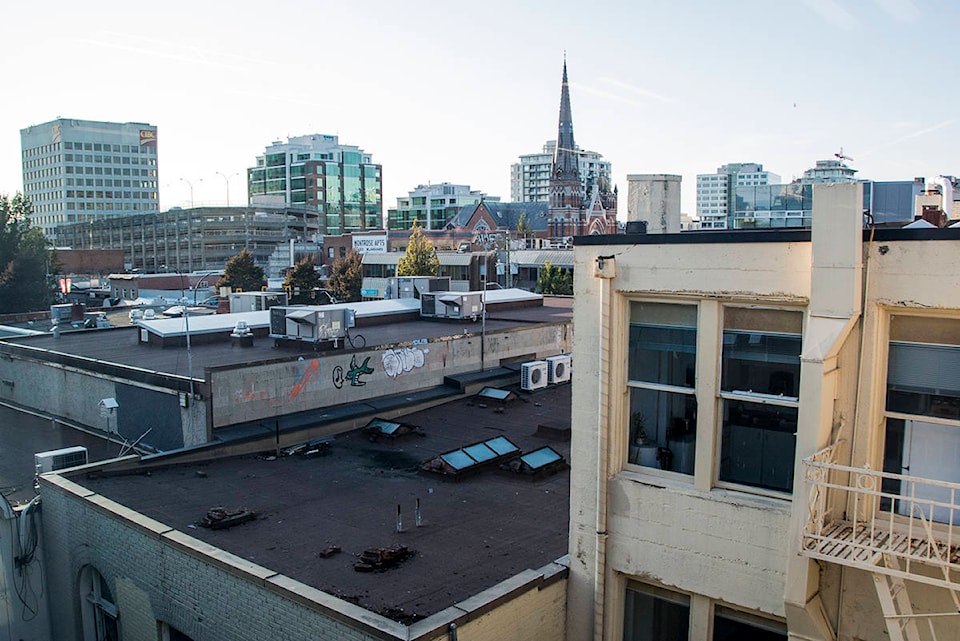It might not be a concrete jungle, but the Victoria Downtown Residents Association (DRA) says green space needs to be prioritized before downtown land is swallowed up by development.
“The main issue is that we aren’t generating the amenities we need to be generating for the rise in the development here,” said Paul Gandall, DRA president. “If you pour more people into an area and you don’t collect the funds to create the amenities for those individuals, you don’t end up with a particularly live-able neighbourhood.”
READ ALSO: Downtown Victoria condo project offers ‘new ethos’ in urban living
Gandall says green space hasn’t been prioritized the way he says it needs to be.
The city’s Downtown Core Area Plan (DCAP) reveals a 17 per cent population increase downtown between 2001 and 2006 and forecasts a significant population growth over the next few decades. Population forecasts from the Capital Regional District place an additional 10,000 residents in the downtown area by 2038.
Composed of the central business district, historic commercial district, Inner Harbour district, residential mixed-use district and Rock Bay district, Victoria’s downtown spans from Bay Street to Superior Street. Green spaces and urban forests are included DCAP’s plan as a method of improving “overall livability.”
“Over 30 years of the lifespan of that particular plan, they’re really looking to try to increase the number of parks and urban greenspace available to these areas,” Gandall notes. “And it just doesn’t feel like we’re making much progress in that direction at this time.”
A number of parks are listed in Victoria’s downtown, but most are composed mainly of pavement. One such area is Bridgehead Green, near Wharf and Store Streets. In a tweet, the DRA notes that the “green” is divided by sidewalks and roads.
Another example is Centennial Square, a significant chunk of park space carved out downtown between Fisgard Street and Pandora Avenue, but again, mostly paved.
“All of those areas, which are open spaces, are not urban green spaces. They’re not parks. They’re just large concrete spaces,” Gandall said.
Bridgehead Green is the fourth of six "parks" in #downtownyyj & it’s our focus today. On the @CityOfVictoria map, all the spare lands around the east end of the bridge are marked as green space, but they are substantially isolated from each other by concrete & roads; pic.twitter.com/dvybawO8lc
— Victoria DRA (@VictoriaDRA) July 22, 2019
Another one of the bigger "parks" identified by @CityofVictoria is Centennial Square. The total area the City identifies as #park is bigger than most would begin to consider as park or green space. #downtownyyj #amenities #equity #healthycities pic.twitter.com/JxKyBUrAye
— Victoria DRA (@VictoriaDRA) July 8, 2019
Victoria’s Parks and Open Spaces Master Plan notes the role of green space in providing a “range of different experiences” and encouraging active living.
“There’s a pretty wide spread acceptance of the idea that close access to green space is definitely important to life experiences,” Gandall said. “It’s good for mental health, physical health. It builds communities. As we move away from a downtown that’s car-based, it makes it increasingly difficult for families to travel to facilities and amenities.”
READ ALSO: Crystal Pool should serve city’s most vulnerable: North Park Neighbourhood Association
Gandall says the notion that only affluent single professionals live downtown is shifting. He says more families are moving in.
“Sometimes there’s an impression that the downtown is either largely commercial or it’s affluent condominium owners,” Gandall said. “But practically speaking, the downtown is really at a point where you have a lot of individuals moving into the area who are younger families and renters…and really do need the ability to take the kids to a playground near by.”
Recently, a Victoria blogger posted about vast unused space in Victoria’s skyline: rooftops.
“Open up the satellite view of Victoria on Google Maps and the rooftops all look pretty black,” wrote blogger and urbanist Thomas Guerrero. “Sure there is the odd green roof here and there but the vast majority of the city looks to be covered with tar paper or gravel.”
“People are always saying they would like more spaces to have recreation or parks downtown, here we have this vast open space that’s just not being used,” Guerrero said in a phone interview with Black Press Media. “In New York you have things like the Highline Park, which uses an old rail line. A school or office building downtown could maybe be turned into a public park.”
Gandall said the DRA hasn’t focused much on rooftops, but likes the idea of transforming idle space.
“If we’re seriously moving towards limiting the presence of vehicles in the downtown core, there’s five city parkades located here…I don’t know about the feasibility of it but switching some of those rooftops into a community space that involves greenery might not be a terrible idea,” he said. “But there’s still so many underutilized spaces that we have in the form of parking lots – or just abandoned lots – that are being held onto by developers for their land value but not necessarily serving the community right now.”
Recently, downtown acquired the Yates Street Community Garden. It’s not quite a park, but it’s a step in the right direction, says Gandall. In the mean time, the DRA will continue pushing for parks.
“There really needs to be some sort of push to purchase either parking lots or other empty land that’s idle, or just better use and design of existing spaces.”
nina.grossman@blackpress.ca
Like us on Facebook and follow us on Twitter
